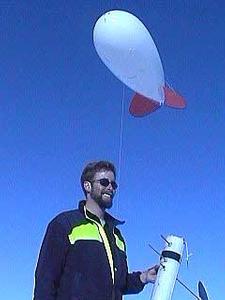
|
|
8 August, 2001
Kites and Balloons
Wednesday, 8 August 2001
God dag!
Where Are We Now?
Our first sunny morning! What a beautiful day in the Arctic. Very little
wind made it wonderful to be outside, working or not. Today, the
Atmospheric Chemistry group had lot's of volunteers from other groups to be
bear guards since everybody wanted to get off the ship but they aren't
allowed to just walk around and visit the different ice camps without a
reason (Where were they yesterday when it was foggy and cold?). Our
coordinates at 10 this morning were 88o34' N/4o19' E and at 10 pm they were
pretty much the same, 88o33' N/4o17' E, so we drifted a little bit south and
a little bit west. Ah, ice is so fickle.
Life on Board
It was such a beautiful day, and I didn't have any duties after lunch, so I
decided to go skiing for an hour for some exercise. The captain and many
others had been out already this morning. The ship has some cross-country
skis and boots to borrow but I had brought my own mountaineering skis and
boots so I checked out a gun and radio and headed out. The snowmobiles have
made tracks and paths to follow all around our ice floe and the bridge keeps
constant tabs on everyone and lookouts so I didn't feel nervous at any time.
What a great experience! You feel almost alone while swooshing through a
wintry landscape of fantastic ice sculptures in various shades of blue and
white and brilliant turquoise ponds of melt water. I didn't take my camera
because I wanted a workout, but regretted my decision later. Hopefully, we
will have another sunny day. I did come across the paw prints of our
visitors from yesterday, bigger than my head with claw marks dragged between
steps, meandering off into the white jumble of ice.
Our onboard doctor, Krister Ekblad, gave a very informative and useful
lecture on hypothermia in the mess hall at 8 pm. Hypothermia is a shutdown
of body functions under cold conditions that may result in death. He also
showed some interesting pictures of frostbite cases (Right after dinner.
Thanks). We learned that most deaths from hypothermia occur under fairly
ordinary circumstances, instead of unusual situations like climbing Mt.
Everest. We also learned how to slowly warm up a person in the field who
shows signs of hypothermia in order to increase their chance of survival.
Scientists at Work
Air Jensen. The Dragon. Michael Jensen from Cooperative Institute for
Research in Environmental Sciences (CIRES), Boulder, Colorado, is an expert
in the air. He attaches an instrument package to either a kite line (if the
wind is good) or to a balloon cable (if the wind is not so good). The
Swedish word for both kite and dragon is "drake" (pronounced dra'ka), so I
always hear this word when the kite is flying, hence the code name Dragon.
I don't know what the Swedish word for balloon is, but I am pretty sure it
wouldn't be as cool for a code name.
The attached instrument package measures temperature, air pressure,
humidity, and wind direction and velocity as it rises up through the
atmosphere. In addition, the balloon carries another instrument to measure
parcticles in the air. It counts how many parcticles there are and their
sizes, from 20 nanometers up to 1 micrometer. Using all of these pieces of
information, Mike can put together a vertical profile of the atmosphere up
to about 2 kilometers above the ice. The other scientists who are measuring
specific chemicals in the air can then use this information to try to
understand where these chemicals come from, how they are moved through the
atmosphere, and where they will end up.
The balloon is amazing. Filled with helium, it is 25 feet long. They
inflated it on the helideck from gas tanks then walked it out to the huts on
the ice, where a motorized winch reels out the cable (It looked pretty
amusing seeing them walk out from the ship, holding a rope with that big
balloon on the other end). Data is logged into a data acquisition program
in each instrument, then downloaded to a computer in the hut. He reels it
out to the desired height then reels in, collecting data the entire time.
Each flight takes about an hour, depending on height and length of time he
leaves it up. Maybe he will let me fly the kite one of these days.
Go fly a kite!
From Deck 4 on the Icebreaker Oden, drifting in the ice, north of 88,
Dena Rosenberger

Mike and his kite

Mike explains how the instrument package works

Contact the TEA in the field at
.
If you cannot connect through your browser, copy the
TEA's e-mail address in the "To:" line of
your favorite e-mail package.
|
